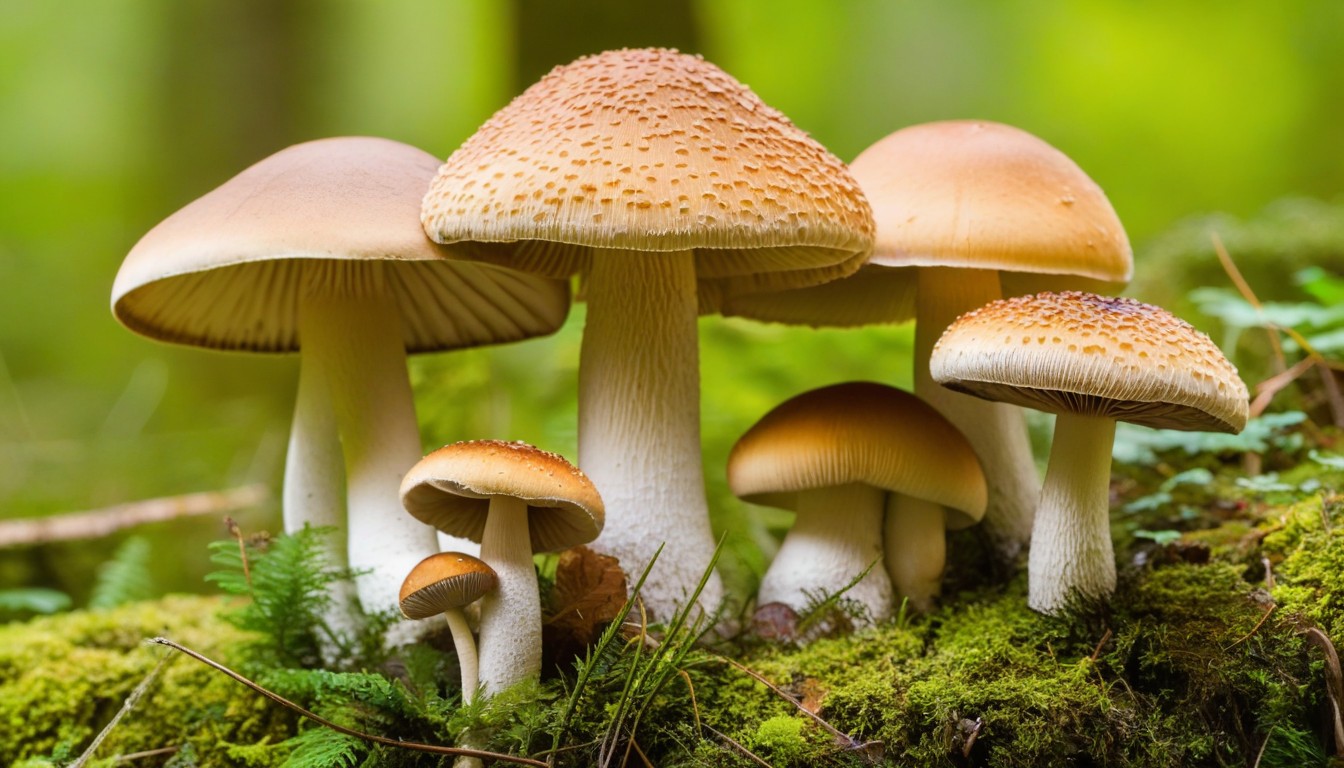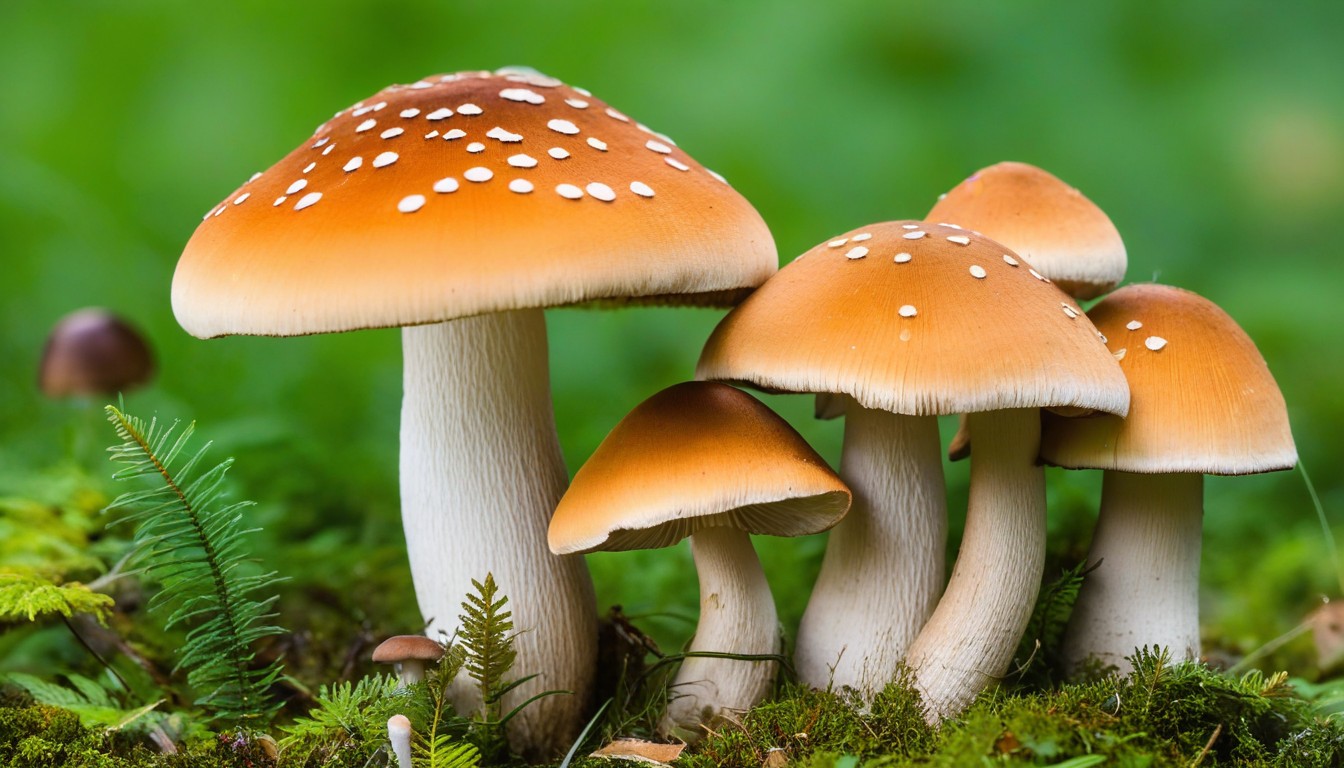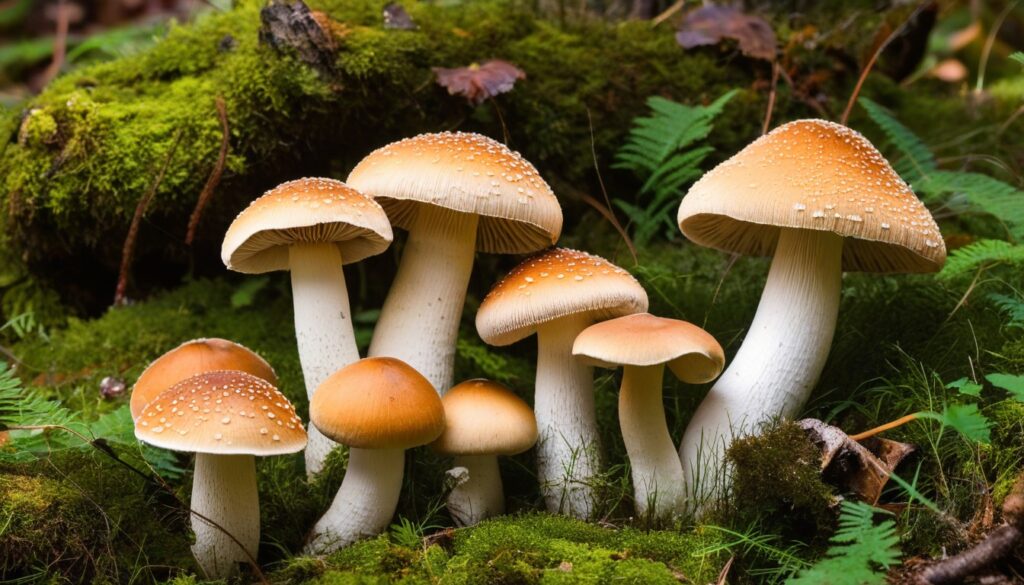If you’re a mushroom enthusiast and live in Indiana, you’re in for a treat. Indiana’s forests are home to a diverse range of edible mushrooms that will excite your taste buds and provide a fun foraging experience. Each mushroom has its own unique flavor and characteristics, making mushroom foraging in Indiana a delight for culinary enthusiasts and nature-lovers alike.
Key Takeaways:
- Indiana forests offer a variety of edible mushrooms for foragers to discover.
- Each mushroom has its own unique flavor and characteristics.
- Mushroom foraging is a fun and exciting experience for culinary enthusiasts and nature-lovers.
- It’s important to correctly identify mushrooms and forage sustainably and responsibly.
- Indiana’s forests provide a wonderful opportunity for mushroom enthusiasts to explore and enjoy the outdoors.
Introduction to Mushroom Foraging

Mushroom foraging can be a fun and rewarding hobby that gets you out into nature and helps you enjoy the natural world around you. Indiana forests are full of a variety of deftly edible mushrooms, each with their unique flavor and characteristics.
Before you start collecting wild mushrooms, it’s essential to learn the basics of mushroom identification and foraging safely. Mushroom foraging requires a keen eye and attention to detail as you navigate the forests of Indiana. It’s critical to understand the differences between edible and toxic fungi and the correct methods for collecting them.
The mushrooms found in Indiana forests are part of a delicate and vital ecosystem. Therefore, practicing responsible mushroom foraging is essential for preserving the natural environment and ensuring that future generations of mushroom hunters can enjoy the same enthusiasm for the hobby.
The importance of sustainable mushroom foraging is not only for preserving the environment, but it also helps maintain the fungi population by allowing them to spread their spores and continue to grow and flourish. As you venture into the forests of Indiana, keep these principles in mind and practice responsible foraging techniques to ensure that this hobby remains sustainable for years to come.
Morel Mushrooms: Indiana’s Springtime Delicacy
When it comes to foraging for mushrooms in Indiana, nothing compares to the highly sought-after morel mushroom. Spring is the season for morels, and they can be found in the forests throughout the state.
What makes morels unique is their cone-shaped cap and honeycomb-like structure, which makes them easily identifiable. They have a meaty and nutty flavor, which makes them a favorite among mushroom enthusiasts.
Morels are typically found in areas with a lot of moisture, such as riverbanks and wooded areas. They usually grow on the ground and can be found near trees like elm, ash, and oak. They can also be found around the roots of dead trees.
It’s essential to properly identify morels before consuming them, as they have poisonous lookalikes. Always forage in groups and follow proper safety protocols when foraging. To cook morels, it is best to soak them in saltwater first to clean them. Then, sauté them in butter with garlic and herbs for a tasty side dish or add them to soups and stews.
Honey Mushrooms: Abundant and Delicious
Honey mushrooms are a versatile and scrumptious edible species found abundantly in the diverse forests of Indiana. These fungi typically grow in clusters and have a range of colors, from brown to yellow. Identifying honey mushrooms can be quite straightforward, as they have a unique veil that covers the gills when they first emerge. As with all wild mushrooms, it is crucial to be 100% positive of the identification before picking and eating honey mushrooms.
Harvesting Honey Mushrooms
When foraging for honey mushrooms, look for hardwood forests, especially those with dead or decaying trees, stumps, or logs. Honey mushrooms grow amongst the roots of these trees and use them as a food source. Fall is the best time for hunting honey mushrooms, but they can also be found in early spring. Ensure you are prepared with a mushroom knife or scissors and a mushroom basket or paper bag for transporting your harvest.
Recipes for Honey Mushrooms
Honey mushrooms’ adaptable texture and savory taste make them perfect for cooking in various recipes. Here are two recipe ideas:
Roasted Honey Mushrooms:
- Preheat the oven to 375°F.
- Clean and slice honey mushrooms into bite-size pieces.
- Toss mushrooms in olive oil, garlic, salt, and pepper to taste.
- Spread mushrooms on a baking sheet and roast for 20 minutes, or until softened and slightly caramelized.
Honey Mushroom Risotto:
- Prepare 4 cups of chicken or vegetable broth in a saucepan and keep it warm over low heat.
- Heat olive oil in a large skillet and add finely chopped onion and garlic.
- Sauté for about 5 minutes or until onions are soft but not browned.
- Add honey mushrooms, rice, and white wine to the skillet, and stir to combine.
- Gradually add a ladleful of broth to the skillet and constantly stir until the liquid has been absorbed. Repeat the process, adding one ladleful of broth at a time until the rice is fully cooked.
- Stir in grated parmesan cheese and season with salt and pepper to taste.
- Serve warm.
No matter how you choose to enjoy honey mushrooms, it’s clear that these tasty and abundant fungi are a highlight of mushroom foraging in Indiana’s forests.
Chicken of the Woods: A Meaty Delight

If you’re a fan of meaty and flavorful mushrooms, then the chicken of the woods is worth adding to your foraging list. This edible fungus got its name because of its meaty texture and savory taste, which is similar to chicken.
Chicken of the woods mushrooms can be found growing on the trunks or stumps of both living and dead trees in the Indiana forests. They usually grow in clusters, with each cluster having overlapping caps that are bright orange or yellow and have a velvety texture. It’s important to note that only young chicken of the woods mushrooms are edible, so make sure you harvest them before they become tough and leathery.
How to Prepare Chicken of the Woods Mushrooms
Chicken of the woods mushrooms are versatile and can be prepared in various ways, making them a popular choice among mushroom enthusiasts. Here are some delicious ways to cook them:
- Grilled: Cut the mushroom into small pieces and grill them on skewers with some olive oil, salt, and pepper.
- Breaded and fried: Coat the mushroom slices in a mixture of flour, eggs, and breadcrumbs, and fry them in oil until golden brown.
- Sautéed: Heat some butter and garlic in a pan, add sliced chicken of the woods mushrooms, and sauté them for a few minutes. Serve them as a side dish or add them to pasta dishes.
Fun Fact
The chicken of the woods mushroom is also known as the sulfur shelf mushroom because of its distinctive sulfur-like aroma.
Next time you’re foraging in the Indiana forests, keep an eye out for the chicken of the woods mushroom. Its meaty texture and savory taste make it a delightful addition to any meal.
Puffball Mushrooms: Fun and Easy to Identify
If you’re just getting started with identifying mushrooms, then puffball mushrooms can be a great place to start. These round, ball-shaped fungi are fairly easy to distinguish from other types of mushrooms, as they typically have a solid, white interior and no visible stem.
There are a few different types of puffball mushrooms you might come across in Indiana forests. Some common varieties include the pear-shaped puffball, the giant puffball, and the gem-studded puffball. While all puffballs are considered edible, it’s important to make sure you’re identifying them correctly and not mistaking them for toxic mushrooms.
Tip: One way to tell if a puffball mushroom is safe to eat is to cut it open and inspect the interior. If it’s completely white and has no noticeable cap or stem, then it’s likely a safe puffball variety. Avoid any specimens with visible gills or a dark center, as these could be poisonous lookalikes.
|
Puffball Mushroom Types |
Characteristics |
|---|---|
|
Pear-Shaped Puffball |
Oval or pear-shaped, typically found on the ground |
|
Giant Puffball |
Can grow up to 2 feet in diameter, found on the ground |
|
Gem-Studded Puffball |
Small, white, round mushrooms covered in small bumps, typically found on wood |
While puffball mushrooms don’t have a lot of taste on their own, they can be used in a variety of recipes to add texture and substance. Some popular ways to enjoy puffballs include slicing them thinly and frying them in butter or oil, using them as a substitute for tofu in vegetarian dishes, or incorporating them into soups and stews.
Overall, puffball mushrooms are a fun and easy type of fungi to identify for novice mushroom hunters. Just remember to double-check your identifications and always err on the side of caution when sampling any wild mushroom species. Happy foraging!
Oyster Mushrooms: A Gourmet Favorite
Looking for a mushroom that can transform a meal into a culinary masterpiece? Look no further than the oyster mushroom. Known for their delicate flavor and versatility in the kitchen, oyster mushrooms are a favorite among culinary enthusiasts and chefs alike.
Indiana’s forests are a hidden treasure trove of gourmet mushrooms. Oyster mushrooms can be found growing on dead hardwood trees or logs, and can often be found in clusters.
|
Characteristics of oyster mushrooms |
Tips for identifying oyster mushrooms |
|---|---|
|
Pleurotus ostreatus |
Look for a fan-shaped cap with a smooth, slightly wavy surface, and a pale, off-white color. The gills are white and decurrent, meaning they run down the stem. Oyster mushrooms have no ring or volva. |
|
D delicate flavor |
Choose oyster mushrooms that are firm to the touch without slimy spots or unpleasant odors. Avoid mushrooms that have become too large or browned. |
|
Versatility |
Oyster mushrooms are perfect for grilling, sautéing, stir-frying, or roasting. They complement a range of dishes, from vegetarian meals to seafood or meat-based dishes. |
Ready to indulge in the gourmet delights of oyster mushrooms? Try our grilled oyster mushroom recipe, perfect for a summer barbecue:
- Preheat your grill to medium heat.
- Clean and slice the oyster mushrooms.
- In a bowl, mix 1/4 cup of olive oil, 3 minced garlic cloves, salt, and pepper.
- Brush the mixture onto both sides of the oyster mushrooms.
- Grill the oyster mushrooms for 3-4 minutes on each side.
- Serve the oyster mushrooms with a squeeze of fresh lemon juice and some chopped parsley.
The subtle, sweet flavor of oyster mushrooms complements the lemony-garlicky marinade in this recipe perfectly. Grilled to perfection, these mushrooms make for a delicious and nutritious side dish or appetizer.
Lion’s Mane Mushrooms: A Medicinal Marvel
Lion’s Mane mushrooms (Hericium Erinaceus) are considered a medicinal marvel due to their potential health benefits. Also known as “bearded tooth,” these medium to large-sized mushrooms have distinctive white, cascading spines that resemble a lion’s mane, hence their name.
According to studies, Lion’s Mane mushrooms may have medicinal properties that include promoting brain function and nerve growth, reducing inflammation, and boosting the immune system. Research has also shown that these mushrooms can help prevent neurodegenerative diseases like Alzheimer’s and Parkinson’s by fostering the growth of nerve cells.
These mushrooms grow on hardwood trees and are usually found in the fall, although they may be available throughout the year. Be prepared to hike and search around where you know hardwood trees grow when looking for them.
When cooked, Lion’s Mane mushrooms have a savory, meaty flavor, similar to crab or lobster meat. They are a versatile ingredient and can be used in many dishes, such as soups, stews, stir-fries, and omelets. They can be sautéed, grilled, roasted, or even used as a vegetarian substitute for crab in crab cakes or as a filling for tacos.
Preparation Tips:
To prepare Lion’s Mane mushrooms, you will need to trim the base of the mushroom and cut it into small bite-sized pieces. They can then be cooked any way you would cook regular mushrooms. Some simple preparation tips include:
- Sautéing in butter with garlic and herbs
- Roasting with olive oil, salt, and pepper
- Grilling with balsamic vinegar and olive oil
- Adding to soups or stews for extra flavor and texture
Overall, Lion’s Mane mushrooms are a great addition to your diet, not just for their delicious taste, but also for their potential health benefits. So next time you’re out mushroom foraging, don’t forget to keep an eye out for these medicinal marvels!
Cauliflower Mushrooms: A Unique Find
Cauliflower mushrooms are a fascinating addition to the variety of edible mushrooms found in the forests of Indiana. These distinctive mushrooms get their name from their distinct appearance, reminiscent of cauliflower florets. Cauliflower mushrooms typically grow in clusters and can often be found on the forest floor near deciduous trees.
These mushrooms have a mild flavor profile, making them a versatile ingredient in various dishes. They are particularly suited to stir-fries, soups, and stews. If foraging for cauliflower mushrooms, it’s important to note that they are often mistaken for other types of mushrooms, so it’s imperative to make sure that they are properly identified before consumption.
You can find cauliflower mushrooms in various locations in Indiana forests, but they are most commonly found in wooded areas with oak and hickory trees. For those who are interested in exploring the world of mushroom foraging, keeping an eye out for these unique fungi can add a new layer of excitement to your journey.
Conclusion
In conclusion, Indiana offers a bountiful selection of edible mushrooms that are waiting to be discovered. Remember to always forage responsibly, taking only what you need and leaving some for others and the ecosystem. Don’t forget to properly identify mushrooms before consuming them and to take all necessary precautions while foraging.
Whether you’re a seasoned mushroom hunter or just starting out, Indiana’s forests have something to offer for everyone. From the exquisite flavors of the morel mushroom to the unique shapes of the cauliflower mushroom, there is a fungi for every palate.
So grab your basket and head out into the woods for an adventure you won’t soon forget. Happy mushroom hunting!
FAQ
What are edible mushrooms?
Edible mushrooms are fungi that are safe for consumption and can be used in various culinary dishes.
Where can edible mushrooms be found in Indiana?
Edible mushrooms can be found in the forests of Indiana, where the diverse ecosystems provide a suitable habitat for their growth.
How do I identify edible mushrooms?
Identifying edible mushrooms requires knowledge of their distinguishing features, such as shape, color, and texture. It is recommended to consult a field guide or seek guidance from experienced foragers.
Are all mushrooms in Indiana forests edible?
No, not all mushrooms in Indiana forests are edible. Some mushrooms can be toxic or poisonous, so it’s essential to accurately identify and differentiate between edible and non-edible species.
What precautions should I take when foraging for mushrooms?
When foraging for mushrooms, it is important to wear appropriate clothing, use proper tools for harvesting, and be cautious of wildlife and potential hazards in the forest. It is also advisable to consult local regulations and obtain any necessary permits.
Can I sell the edible mushrooms I forage?
Selling foraged mushrooms may require specific licenses and permits, as regulations can vary depending on the location. It is recommended to research and comply with local laws and regulations regarding the sale of wild mushrooms.
Are there any poisonous mushrooms in Indiana forests?
Yes, there are poisonous mushrooms in Indiana forests. It is crucial to be knowledgeable about the differences between edible and poisonous species to avoid any potential health risks.
Are there any specific seasons for mushroom foraging in Indiana?
Yes, different mushroom species have specific seasons for growth and fruiting. It is important to learn about the specific timelines and conditions favorable for the mushrooms you are interested in foraging.
Can I store foraged mushrooms for a longer period?
Yes, foraged mushrooms can be stored for a longer period by properly drying or preserving them. The specific method will depend on the mushroom type and desired use.
What are some popular recipes using edible mushrooms?
There are numerous recipes that feature edible mushrooms, such as mushroom risotto, sautéed mushrooms, mushroom soup, mushroom pasta, and mushroom stir-fries. The possibilities are endless!

